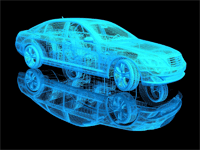
Auto Data Being Culled to Understand Driver Preferences

Automotive electronics that have enabled the installation of what amount to networks in vehicles are delivering a raft of new telematics and other features for drivers. These systems are also generating huge volumes of data – 25 gigabytes an hour, according to one estimate – that auto makers are struggling to harness as a way to better understand customer trends and preferences.
Call centers, sales and marketing were the traditional methods used to gather customer data. Emerging big data platforms like Apache Hadoop are now prompting automakers to rethink how they handle growing volumes of customer data.
Auto makers are “looking for ways to bring all of this rich data back in-house, combine it with other internal data such as [vehicle identification numbers], warranty and telematics and also leverage external sources of data such as social media and insurance to create a deeper understanding of the customer and the customer’s household and extended relationships,” Dan Ricci, an IBM big data analyst and automotive specialist, asserted in a July 17 blog post.
Customer data can now be correlated with public databases such as those maintained by state motor vehicle agencies to determine, Ricci cites as an example, when a family with a teenager is eligible to receive a driver’s license. That information along with prior knowledge about what vehicles the family currently owns could be used to tout safety and reliability ratings, Ricci said.
Such instances are described as using big data and analytics to improve manufacturers’ “next-best-action.” Explained Ricci, “Next-best-action is a data-driven interaction with the customer as opposed to the very one dimensional ‘scripted’ dialogues defined with if-then-else interaction.”
Ricci argued that using emerging capabilities like Hadoop and “master data management” techniques provide a broader understanding of customers based on their current situation and preferences.
Still, there has been consumer push back as aggressive marketers seek to leverage public data. One controversial use of vehicle information focuses on auto warranties. Warranty information is available on states motor vehicle databases that in some cases have resulted in deceptive advertising campaigns using official looking notices aimed at convincing car owners to purchases extended auto warranties.
Auto manufacturers currently spend millions of dollars on customer loyalty programs and incentives designed to retain customers and attract new ones. Ricci argued that big data could be used to improve these programs by providing more granular customer data.
Leveraging big data and analytics, car makers would be “able to track customer interactions across channels such as call centers, web and mobile, and map that customer behavior to incentives and treatments offered by the OEMs intended to retain customers and drive loyalty. OEMs can now track the effectiveness of programs against real customer responses and hopefully their next purchase,” Ricci wrote.
Meanwhile, the amount of data being churned out by high-end vehicles is expected to grow exponentially. IBM said researchers are experimenting with vehicles that could generate as much as 250 gigabytes of data per hour.
Related items:































